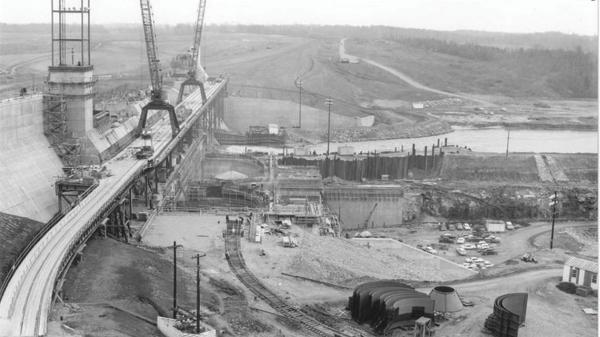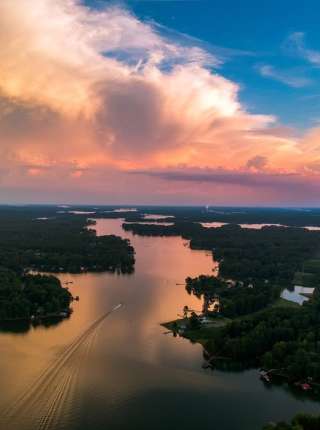A little over 60 years ago, the bed of Lake Norman was dry. People lived, worked, died, and were buried around the Catawba River before the land around it was bought up by the then Duke Power Company (originally the Catawba Power Company), now Duke Energy, to build a dam.
Lake Norman is a man-made lake created between 1959 and 1963 after the Duke Power Company built the Cowan’s Ford Dam across the Catawba River.
The plan for the dam was conceived in the 1890s by an engineer working on the Niagara Falls dam who proposed damming the Catawba for hydroelectricity to James Buchanan Duke in 1905. Duke funded the Catawba Power Company to carry out the idea. Lake Norman was not the first of Duke Electric’s artificial lakes, but the seventh and final one built.

Photo Courtesy Westport Marina
Lake Norman was the largest of Duke’s lakes covering more than 32,000 acres of surface, spanning four counties, and 520 miles of shoreline. The Cowan’s Ford Dam is about 120 feet below Lake Norman and about 70 feet tall.

Photo Courtesy Charlotte Observer
Underneath the lake, there are the remains of a summer camp that opened in 1938 and the site of the Battle of Cowan’s Ford where General William Lee Davidson fought Lord Cornwallis in 1781. There are the original sites of graveyards moved to higher ground like the Cornelius Family Cemetery and the Hunters Chapel M. E. Zion Church Cemetery. There are old plantations, old homesite, old highways, there is even an airplane discovered by firefighters using sonar in 2013.
The Davidson College digital archive catalogues the sites and history that the lake covers. It includes an interactive map of the locations and descriptions of each site. Click here to explore the archive yourself.
The Long Island Mill, one of the earliest cotton mills in the American South, opened in the mid-1800s, and closed in 1959 before being covered by Lake Norman.
Photo Courtesy Charlotte Stories
Lauren Sullivan told WFAE in 2018 that when she’s wakeboarding on Lake Norman, she feels like she is dancing on the sky of the people who used to live on the lakebed. She wanted to know more about what is underneath the lake.

Donna Campbell, in her 2013 article for Our State magazine, recalls her first visit to Lake Norman in 1963. Her father brought her siblings and her to a leased waterfront lot on the edge of the new lake where her family and others could spend the summer in and out of the water and new businesses sprung up on the lakeshore.
Duke Power's plans to construct Lake Norman began in 1904 with the purpose of providing fresh water and flood control. Today it is a popular travel destination where people can experience the lake life for themselves!
It was not just people’s land, but old highways and bridges as well. The old 150 Highway is underneath the lake, as is the Beaties Ford Bridge, which crossed the Catawba River as part of Highway 73.

Jetton Park
Sources and further reading
Our State Magazine's "The History of Lake Norman" article
WFAE's "FAQ What Lies Beneath Lake Norman" stream
Davidson College's Under Lake Norman mapping project
Duke Energy's "A Rare Look Inside Cowan's Ford Dam" article
Or shop for Lake Norman books on our online store for more photos, facts, and history about Lake Norman such as Around Lake Norman and History of Lake Norman!













